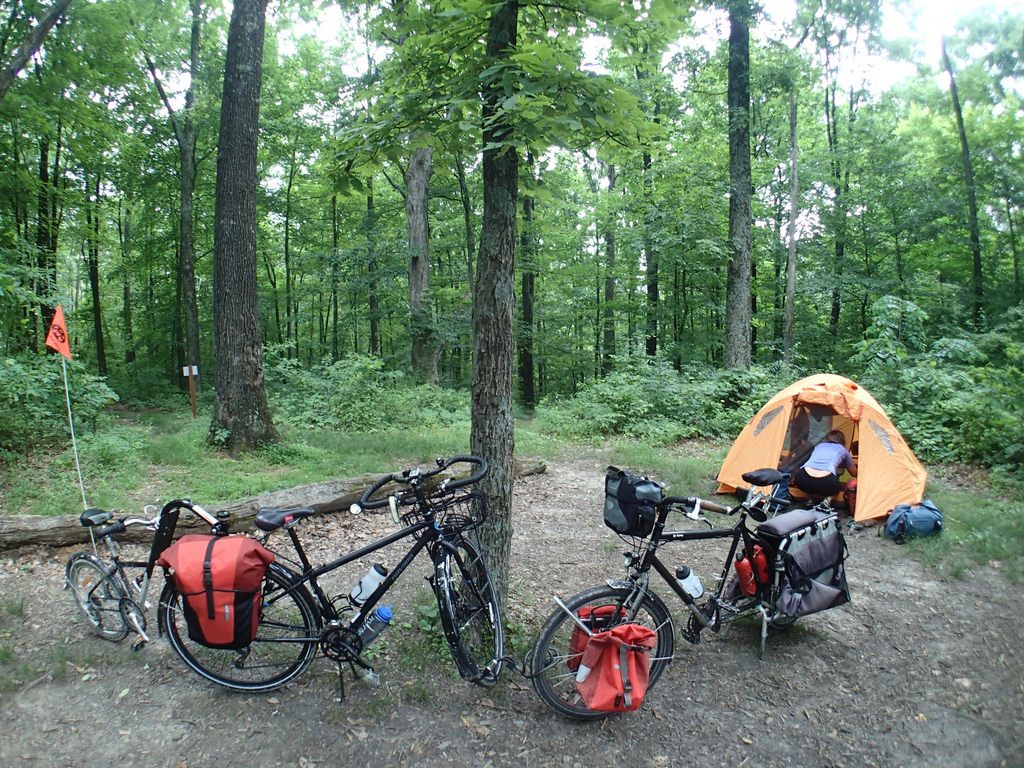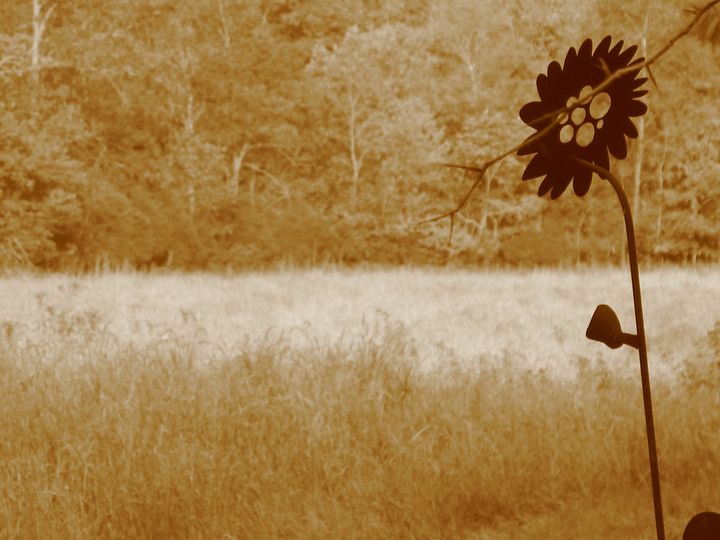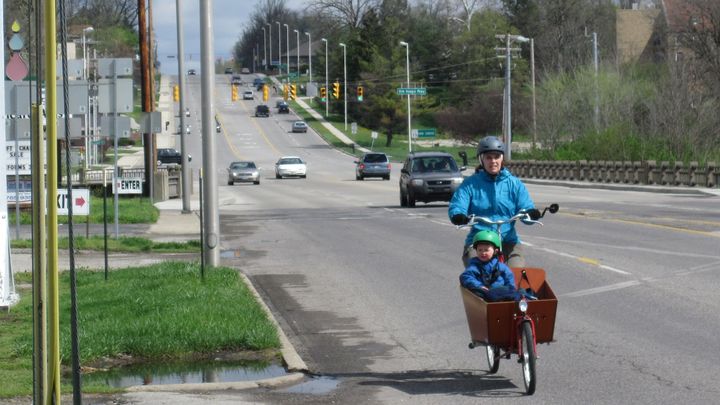Top Five Tools for Bike Tour Route Planning

From my experience bike touring, here are the top tools to use to plan and navigate a bike route:
- Ride With GPS is the tool for advanced bike route planning. Beyond just providing “bike directions”, you can add custom waypoints to your maps, like icons for ice cream stands. You can add custom items to the “cue sheet”, which could be spoken to you during audio navigation. Like “Turn right here for ice cream stand”. Using the “Event” feature, you can group together multiple routes. By putting all your daily route plans into an “Event”, you can visualize the entire trip route on a map. It’s easy to duplicate an route to create an alternate route for the same day, or group together several routes together as part of a tour. You can make excellent printed cue sheets if you’d like a paper copy. There’s also a first-class companion phone app that allows for fully offline turn-by-turn navigation. This is important both to preserve phone battery and since you can’t rely on having a phone signal everywhere. In offline mode you can still get turn-by-turn audio directions, with the screen waking up near intersections and then sleeping again to preserve battery. The downsides to Ride with GPS is that it it’s bike directions aren’t aways the best and you can’t plan new routes from your the phone app. However, other tools can fill those gaps. The full set of tools are available for $6/month, and you can cancel the monthly membership when you home from your tour if you like.
- Strava Heatmap The Strava Heatmap is an invaluable asset because it shows you a full map of where cyclists actually record rides. Popular routes appear visually bolder on the heatmap. You can see the map at the Strava Labs Heatmap page, but this isn’t the best way to experience it. Create a free Strava account and go to the page to create a new Strava route. Click the gear on the left side and enable “Global Heatmap”. Also note the “Use Popularity” option, which is enabled by default. Here you can create routes based roads cyclists actually use. The “Popularity” option skews the results towards rides Strava users have added to the heatmap. Compare the results to routes created by Ride with GPS and adjust accordingly. Keep in mind that most Strava data is skewed towards assertive cyclists riding in their local area. They may also be local loop rides and not longer point-to-point routes.
- Google Street View Just as the Strava Heat Map shows you routes that are actually used by cyclists, spot-checking road sections with Google Street View can show you actual road conditions. You can check if a road looks newer or worn out, whether there is a shoulder, and see what traffic was around the street view traffic at the time the photos were taken. If a few different spot checks on a road all turn up shots of traffic, there’s a reasonable chance you can expect similar conditions.
- Maps with Me phone app If you don’t take paper maps, a “paper map equivalent” is highly recommended— a complete offline digital map of the area. Expect that planned routes may need to adjusted on the fly due to accidents, weather, construction or outdated information, like the bridge on my route that no longer existed. I recommend the Maps with Me app. They use OpenStreetMap data, which is rather complete, at least around the United States. In normal use, you just get to see your dot your map. Be aware that topo maps are not included. (The Ride with GPS offline maps do include Topo maps, but the only the parts near a planned route). Maps with Me also supports showing a planned route on the map in the KML/KMZ formats. When I used it, there was a tedious workflow for importing KML files: You would email the file to yourself, and then click on the attachment to have it open in the app.
- GPX2KML Strava and Ride with GPS support exporting in the GPX format. Using the GPX2KML site, you can easily convert GPX formatted files into KML. You can then email the KML file to yourself so that it may be imported into Maps with Me on your phone. Hopefully Maps with Me will support GPX directly in the future as well as easier importer.
- Warm Showers is a mutual hospitality network for bike tourists. You can host bicycle tourists when you are at home (which we have much enjoyed) and then when you are bike touring the hosts in the network may offer free space to camp, housing and possibly food. Hosts are often located in cities and towns, so cross reference the towns you pass through with the Warm Showers map. The service is available through a website as mobile apps. Unfortunately for families, as your group size grows the number of hosts with space and interest to host you declines.
Also Useful
- USB power bank If you are going to be doing paperless navigation, backup battery power is highly recommended. While generating electricty through solar power or from a dynamo are possible, a 10,000mAh USB power bank will likely charge a device at a faster rate, and can hold the equivalent of about 4 full phone charges. This is likely sufficient if you are going to have access to electricity every 2 to 3 days. We started the trip with 2 USB power banks, but sent one home halfway through. We still had USB charging from my dynamo as a second source of power.
- USB charging hub Instead of bring a bunch of different USB chargers for each device, we brought a single 5-port USB charging hub. Not only did this mean less things to pack, we were able to maximize the number of devices that we could charge at once from a single electrical outlet. Especially for phones and larger devices, look for a charger that provides at least 2 Amps per port for fastest charging. We used a device from Anker.
- Waterproof phone protection Many modern phones are waterproof, but if yours is not, consider adding some protection. Plan to need to use your phone while it’s raining by having a cover that allows touch functions to work will protecting it from water. Even if you don’t look at the phone frequently, having a handlebar mount can let you hear audio cues from your phone. A phone stored inside a handlebar bag or pocket may be too muffled to hear. I used an older version of the Ortlieb Smartphone Case that allowed me to fish in a USB cable for continuous charging will still retaining most of the waterproofing. My version also included attachments for the top of an handlebar bag. A similar product that Ortlieb sells now is called Safe it.
- Google Navigation Google’s bike directions are good as a last resort. There is some ability for them to work offline, and some ability to cache maps for offline use. The downsides are that the time I used it lacked a clear online/offline boundary. The offline maps are cached, not saved permanently and only include particular areas. Also, Google in the past have been aggressive about declaring that things are roads. In the past Google has sent me down gravel roads and even riding through a flowing creek (no bridge). I trust Google bike directions in a city where there is a good data connection and few gravel roads. I don’t rely on it for rural expeditions anymore if I have other options.

![photo in waterproof Ortleib case, powered by dynamo via Luxos U light. GPS watch functions as bike computer]](https://i0.wp.com/bikes-as-transportation.com/wp-content/uploads/2017/02/ortleib-phone-holder-plus-watch-580x773.jpg?resize=580%2C773)
Surprisingly not essential
Here are some items which might be surprising that I don’t use:
- GPS head unit for the bike. One of these could certainly be a good investment, featuring an always-on screen that can be read in bright sunlight and a great battery life. Built-in Waterproofing is also a feature. I just don’t need one that often and thought my phone combined with an extra battery could work sufficiently well and it did. It also saved me from buying and carrying one more thing, since I was going to have the phone and USB power bank anyway.
- Bike Computer I don’t have a a bike computer on my Big Dummy because I mostly ride it around town. The ride stats aren’t that interesting around town and the device might be stolen. I did already own a Garmin GPS running watch, the Forerunner 235. I used the watch as a cyclometer on the bike trip to avoid keeping the phone screen on, running down the phone battery further. The watch mounts to the bike easily with an official handlebar mount. Like a bike-specific GPS device, the watch has a “bike mode” with an always-on, easy-to-read screen and great battery life, easily handling 8+ hours on the bike. As bonus, the watch produces it’s own GPS trace of the trip. It’s not designed to help with GPS navigation though. The watch charges via USB along with our devices. I wouldn’t have bought the watch just for a bike trip, but it worked great to stand-in a for a cyclometer that I don’t normally want.
- Paper Maps Instead of bringing a paper backup map, I loaded the Ride with GPS and Maps with Me data on my wife’s phone in case mine died, and loaded a third copy of the Maps with Me data on my one of my kid’s tablet as yet-another backup. This solution added no weight and was resilient to all kinds of failure: one battery dying, one device dying or one map source being bad.
What are your favorite tools for bike touring? Leave them in the comments below.



Comments ()